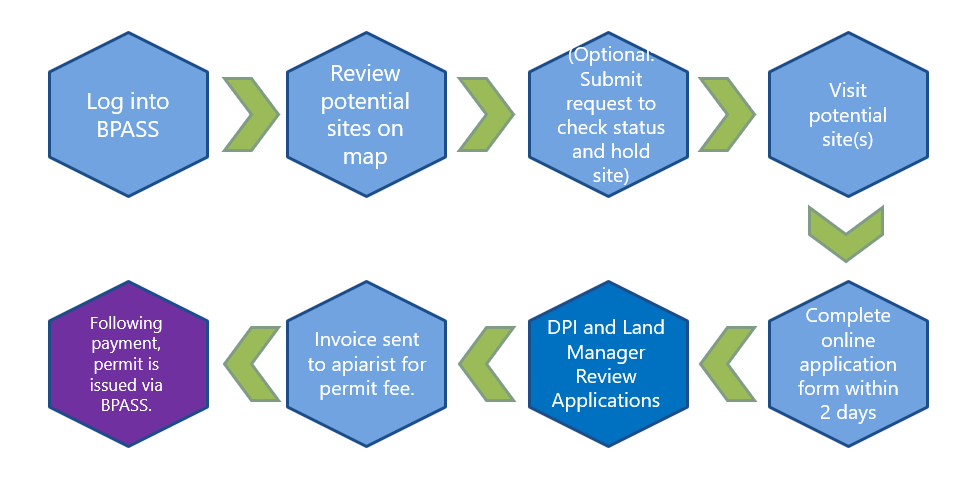
Long Term Vacant Sites
To keep beehives (an apiary) on public land in NSW you must hold a permit or license to do so from the government agency that manages the land. In accordance with the NSW policy framework for apiary sites on public land, the process for allocation of sites which have not been used for over 2 years (“Long Term Vacant sites”) is on a first-come, first-served basis for qualifying apiarists.
Following a successful pilot with Forestry Corporation and LLS, Long Term Vacant Sites are now published on the BPASS portal. Applicants should be aware that these sites have not had an apiary permits for at least two years or in many cases may never have been used as beekeeping sites at all.
Interested parties should note that these sites have not been inspected or reviewed before publishing and may not be suitable for beekeeping. Before applying for an apiary site, applicants must visit the site and ensure it is suitable for their operation.
Available sites are now published via the BPASS portal. A public map is available to identify sites. To apply for sites you must be an apiarist registered in NSW and apply via the BPASS portal.
The following diagram shows the process to follow to apply for sites. To request a hold, check a site's status or lodge an online application, log into BPASS and submit a hold or application using the steps listed on the BPASS Help page.
What do I need to do to prepare to apply for an LTV site?
- Ensure that your beekeeping registration is current.
- Ensure that your insurance is current and meets Forestry Corporation’s insurance requirements outlined in their Apiary Permit Terms and Conditions.
Can I request that a site be held for me while I visit the site?
Yes, if you have not visited the site and want to ensure the site is suitable for your operation, you can submit a hold request on BPASS for the sites. If you do not apply for the sites within 2 business days they will be available again for other applicants.
To ensure broad access to sites you can request up to 20 sites be held at any one time but you can only request a hold on a site once.
How long will it take to confirm a site has been held?
If there are no existing holds or applications in progress for the site you will be granted a hold immediately. If another beekeeper has applied for a hold or submitted an application you may have to wait for that hold or application to expire before applying.
How long will it take before a permit is issued once I submitted an application form for a site?
Approval of all applications is completed online by the respective land manager. This may involve checks to ensure the sites are still suitable and not subject to any conflicting uses. This process can take a number of weeks depending on the volume of applications. If you would like an update on your application please contact the apiary sites service desk at apiary.sites@dpi.nsw.gov.au with details of the site(s) applied for.
How will “First Come, First Served” be determined?
Whichever comes first:
- The receipt of an application for a specific site.
- Receipt of a hold for a specific sites that is followed by an applications for the site within 2 business days after the hold application.
Can my setdown site be anywhere within the range on the map?
Some Forestry Corporation ranges may contain “Exclusion Zones” where setdown sites cannot be placed. Exclusion Zones will be marked in mustard colour on the map and cannot be used as setdown sites. Setdown sites outside these areas should be identified in accordance with Forestry Corporation’s Apiary Permit Terms and Conditions and the location notified to Forestry Corporation within 90 days of the permit commencing.
On LLS Travelling Stock Reserves there may be multiple apiary sites within a reserve and each reserve may be marked with several segments on the map. Approximate setdown points are marked on the map. It may be possible to put your hives nearby as long as the location is within the reserve and you meet the following requirements:
- Where possible, hives should be placed at least 200 metres from:
- Any watering point.
- Any gateway or other access to the reserve.
- Any public thoroughfare, road or track within the reserve.
- Any stock holding yards.
Will the map be updated immediately when sites are held or allocated?
Yes, you can see if a site has received a hold or application by clicking on the site in the BPASS map. You will still be able to request a hold or apply for the site until any previous holds or applications have been finalised and a permit issued to the original applicant.
How can I enquire about Long Term Vacant sites on Forests or TSRs that do not currently display apiary sites?
Not all public lands are suitable for apiary sites. Features such as access issues, sensitive ecosystems, other conflicting uses or proximity to residences may mean that a location is not suitable for an apiary site. If you identify a location that you believe may be suitable for future use for beekeeping, contact the apiary sites service desk at apiary.sites@dpi.nsw.gov.au with details of the location of the site so they can review with the relevant agency and advise the next steps. NSW National Parks and Wildlife Service Apiary sites are subject to NPWS’s beekeeping policy which limits the number of apiary sites. There are no current LTV NPWS sites.


